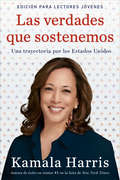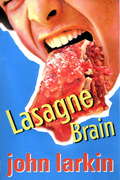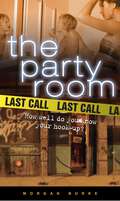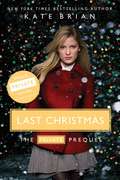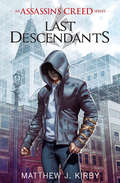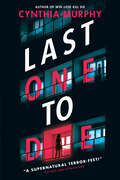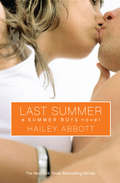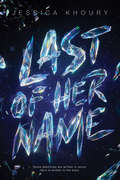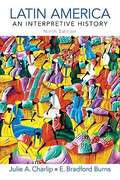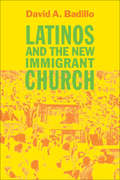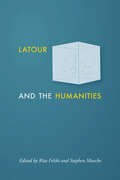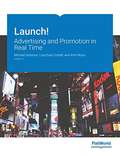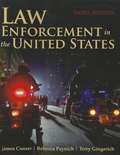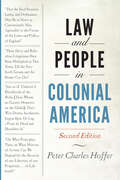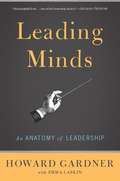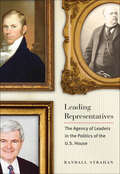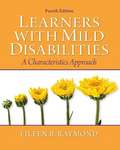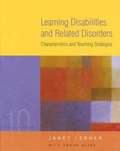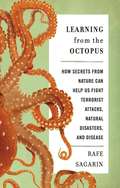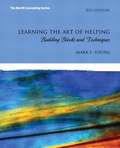- Table View
- List View
Las verdades que sostenemos: (Edición para lectores jóvenes)
by Kamala HarrisComo la primera mujer de la raza negra y con raíces en Asia Meridional que se convierte en vicepresidenta de los Estados Unidos, así como la segunda mujer negra en la historia elegida al Senado de los Estados Unidos, Kamala Harris está abriendo nuevos caminos en su ruta hacia el escenario nacional. Pero, ¿de qué manera alcanzó sus metas? ¿Qué valores e influencias la guiaron e inspiraron sobre la marcha? En esta edición de sus memorias para lectores jóvenes, conocemos cómo su familia y su comunidad influyeron en la vida de la vicepresidenta Harris y vemos qué la llevó a descubrir su propio sentido de identidad y propósito. Las verdades que sostenemos sigue la trayectoria que la vicepresidenta Harris ha elegido a lo largo de su vida al explorar los valores que más aprecia: los de comunidad, igualdad y justicia. A través de una lectura que inspira y empodera, este libro nos reta a convertirnos en líderes de nuestras vidas y nos muestra que, con determinación y perseverancia, todos los sueños se pueden hacer realidad.
Lasagne Brain
by John LarkinEric Underwood, also known as Spaghetti Legs and Pizza Features, serves up the final course in the pasta trilogy: Lasagne Brain. Eric would love to be an intellectual and here he unexpectedly takes the journey from boyhood to manhood, and the only question he wants to ask is: can he go back? With his mind-boggling essays driving teachers out of their minds, the love of his life Veronica Roberts dumping him, his best friend hanging round Woolies with a trolley full of bananas hoping to pick up more than potassium poisoning, and his father watching pre-recorded golf, there?s only one thing for Eric to do: retreat to his bedroom in self-imposed exile. Eric?s ambition is to lock himself away for the rest of his teenage years. And if it wasn?t for the Teletubbies and the arrival of Imelda, the Scots girl he French kissed in an English pub, he might just have made it!
Last Call (Party Room #3)
by Morgan Burkethe party room. On Manhattan's Upper East Side. Everybody's fabulous. No one gets carded. Then someone dies. The Prep School Killer is dead. Finally Kirsten can go on and leave the nightmare of her best friend Sam's murder behind her. Kirsten's at NYU now, but she still slips back to the Party Room on the Upper East Side of Manhattan--where the horror all began. But it's quiet now. Just Kirsten and her old friends and a mojito or three. Then the killer strikes again. And again. The killer wasn't Kyle after all. Someone's looking to settle the tab. Don't be the last one when the bar closes.
Last Christmas: The Private Prequel (Private)
by Kate BrianAriana Osgood has everything an Easton Academy girl could want: straight A's, the perfect boyfriend, and a coveted spot in exclusive Billings House. But on the first night of Christmas vacation, a blizzard traps her on campus with irresistible bad-boy Thomas Pearson. Alone. Instead of snuggling with her boyfriend next to a cozy fire in Vermont, she's huddling for warmth with Thomas in Ketlar House. As the snow transforms Easton into a winter wonderland, Ariana finds herself falling for Thomas. But someone is watching their clandestine romance unfold, someone intent on turning their holiday weekend into a nightmare... Last Christmas reveals the secret of what really happened before Private began -- and the shocking truth will change everything for fans of Kate Brian's bestselling series.
Last Descendants: An Assassin's Creed Novel Series (Last Descendants: An Assassin's Creed Series #1)
by Matthew J. KirbyAn all-new series based on the hit Ubisoft(R) video game franchise "Assassin's Creed." Part historical fiction, part tie-in, this novel creates an all-new narrative fans of the video games will love.Nothing in Owen's life has been right since his father died in prison, accused of a crime Owen is certain he didn't commit. Monroe, the IT guy at school, might finally bring Owen the means to clear his father's name by letting him use an Animus-a device that lets users explore genetic memories buried within their own DNA. During a simulation, Owen comes uncovers the existence of a powerful relic long considered a legend-the Trident of Eden. Now two secret organizations will stop at nothing to take possession of this artifact-the Brotherhood of Assassins and the Templar Order. It becomes clear the only way to save himself is to find the Trident first.Under the guidance of Monroe, Owen and a group of other teenagers go into a memory they all share within their DNA: the 1863 Draft Riots in New York City. Owen and his companions will find themselves tested on the violent streets of New York, and their experiences in the past will have far-reaching consequences in the present.
Last One to Die
by Cynthia MurphyFrom TikTok's "CEO of plot twists" comes a supernatural thriller that will keep you guessing until the very end. Packed with voice-driven whodunit storytelling, and a classic slasher-movie feel, this dark, pacy, and irresistibly creepy thriller really has something for everybody!16-year-old, Irish-born Niamh has just arrived in London for the summer, and quickly discovers that girls who look frighteningly like her are being attacked.Determined to make it through her Drama Course, Niamh is placed at the Victorian Museum to put her drama skills to the test, and there she meets Tommy: he&’s kind, fun, attentive, and really hot! Nonetheless, there's something eerie about the museum...As present-day serial attacker and sinister Victorian history start to collide, Niamh realizes that things are not as they seem. Will she be next?
Last Summer (Summer Boys #4)
by Hailey AbbottThe sweet, smart, and sexy final installment in the New York Times bestselling series.It's the last summer at Pebble Beach before everyone goes off to college. George and Beth are no longer together, but will they make up before Beth heads off to (oh, the irony) GEORGEtown? Kelsi has a new college boy around for the summer, but can he make her pulse flutter the way Tim used to? Meanwhile, Ella runs into a dangerous blast from the past...can she resist him? Between sipping homemade margaritas by the shore, and helping each other through their romantic woes, the Tuttle girls might just make this the craziest, sweetest, most unforgettable summer ever.
Last of Her Name (Scholastic Press Novels Ser.)
by Jessica KhouryFrom Jessica Khoury, author of the Corpus Trilogy, comes a gripping story of royalty and rebellion, coursing across a far-away star system like a trail of jewels.Sixteen years ago, rebellion swept the galaxy known as the Belt of Jewels. Every member of the Leonov royal family was murdered--down to their youngest child, Princess Anya--making way for the Union government to seize power. But Stacia doesn't think much about politics. She spends her days half-wild, rambling her father's vineyard with her friends, Clio and Pol. That all changes when a Union ship appears burning through the sky, bearing the leader of the Union, the Direktor Eminent himself, who declares that Stacia's sleepy village is a den of empire loyalists. Even more shocking, the Direktor claims that Princess Anya Leonova is alive--and Stacia is the lost princessAs their home explodes into chaos, Pol smuggles Stacia to a hidden escape ship, leaving Clio in the hands of the Union. With everything she knows threading away into the stars, Stacia sets her heart on a single mission:She will find and rescue Clio, even with the whole galaxy on her trail.
Latin America: An Interpretive History (Ninth Edition)
by Julie A. Charlip E. Bradford BurnsFor courses in the History of Latin America and Modern Latin America. Organized thematically, this text offers a clear narrative that weaves the story of Latin America together with coverage of broader themes and regional differences. In addition to the great diversity within Latin America, there is also a common theme that encompasses the sweep of history in the region. The original author of the text, E. Bradford Burns, cast the problem as the paradox that poor people inhabit rich lands. The reason for this paradox is that a tiny group of elites confuses their nation's well-being with their own. When this text was first published in 1972, there were very few texts on Latin America, and the ones that existed largely read like catalogs of historical events. Although there are others now, this textbook is still a leader in the field because of its clear thematic organization and a central narrative that tells a cohesive story, albeit with many variations. Co-author Julie A. Charlip is committed to continuing the Burns legacy. Despite changes in research, interpretations, and theories, Burns's basic premise is still the most accurate and succinct, providing the best framework for approaching the region.
Latinos and the New Immigrant Church
by David A. BadilloLatin Americans make up the largest new immigrant population in the United States, and Latino Catholics are the fastest-growing sector of the Catholic Church in America. In this book, historian David A. Badillo offers a history of Latino Catholicism in the United States by looking at its growth in San Antonio, Chicago, New York, and Miami. Focusing on twentieth-century Latino urbanism, Badillo contrasts broad historic commonalities of Catholic religious tradition with variations of Latino ethnicity in various locales. He emphasizes the contours of day-to-day life as well as various aspects of institutional and lived Catholicism. The story of Catholicism goes beyond clergy and laity; it entails the entire urban experience of neighborhoods, downtown power seekers, archdiocesan movers and shakers, and a range of organizations and associations linked to parishes. Although parishes remain the key site for Latino efforts to build individual and cultural identities, Badillo argues that one must consider simultaneously the triad of parish, city, and ethnicity to fully comprehend the influence of various Latino populations on both Catholicism and the urban environment in the United States.By contrasting the development of three distinctive Latino communities—the Mexican Americans, Puerto Ricans, and Cuban Americans—Badillo challenges the popular concept of an overarching "Latino experience" and offers instead an integrative approach to understanding the scope, depth, and complexity of the Latino contribution to the character of America's urban landscapes.
Latour and the Humanities
by Rita Felski and Stephen MueckeHow does the work of influential theorist Bruno Latour offer a fresh angle on the practices and purposes of the humanities?In recent years, defenses of the humanities have tended to argue along predictable lines: the humanities foster empathy, the humanities encourage critical thinking, the humanities offer a counterweight to the cold calculations of the natural and social sciences. The essays in Latour and the Humanities take a different approach. Exploring the relevance of theorist Bruno Latour's work, they argue for attachments and entanglements between the humanities and the sciences while looking closely at the interests, institutions, and intellectual projects that shape the humanities within and beyond the university. The collection, which is written by a group of highly distinguished scholars from around the world, is divided into two sections. In the first part, authors engage in depth with Latour's work while also rethinking the ties between the humanities and the sciences. Essays argue for greater attention to the nonhuman world, the urgency of climate change, and more nuanced views of universities as institutions. The second half of the volume contains essays that reflect on Latour's influence on the practices of specific disciplines, including art, the digital humanities, film studies, and political theory.Inspiring conversation about the relevance of actor-network-theory for research and teaching in the humanities, Latour and the Humanities offers a substantial introduction to Latour's work while discussing the humanities without falling back on the genres of either the sermon or the jeremiad. This volume will be of interest to all those searching for fresh perspectives on the value and importance of humanistic disciplines and thought.Contributors: David J. Alworth, Anders Blok, Claudia Breger, Dipesh Chakrabarty, Yves Citton, Steven Connor, Gerard de Vries, Simon During, Rita Felski, Francis Halsall, Graham Harman, Antoine Hennion, Casper Bruun Jensen, Bruno Latour, Heather Love, Patrice Maniglier, Stephen Muecke, Barbara Herrnstein Smith, Nigel Thrift, Michael Witmore
Launch! Advertising and Promotion in Real Time
by Michael Solomon Lisa Duke Cornell Amit NizanLaunch! is written for advertising and promotions courses taught to students in the business school and journalism & mass communication students. This book is the first of its kind to teach advertising concepts by reverse engineering a real advertising campaign from beginning to end. In April 2007, SS+K, an innovative New York City communications agency, launched the first ever branding campaign for msnbc.com with the tag "A Fuller Spectrum of News." Launch! follows that campaign from initial agency pitch through roll-out of print and media assets to post-campaign analysis. Throughout, it exposes readers to the theory and concepts of advertising and promotion, and the personalities and decisions that drove this campaign. The book takes a rare look "behind the curtain" - even letting you see some of the paths not chosen by the agency and client. Students get a realistic sense of how theory plays out in practice. They get a flavor for the exciting field of advertising. And, they consistently learn the perspectives of both the advertising agency (where many journalism and communications students will work) and the client (where many marketing majors will work). This is a unique book, with a unique perspective, by a unique author team, and you won't find this kind of insight in any other text on the market.
Law Enforcement in the United States
by James A. Conser Rebecca Paynich Terry E. GingerichThis book is an ideal introduction to law enforcement and goes beyond discussions of local policing to examine how forces like technology, privatization, and the threat of terrorism are affecting law enforcement on local, state, and national levels. Readers will learn how these diverse and unpredictable forces are shaping the future of law enforcement in the United States, and will come away with the ability to think critically about law enforcement issues. New Material added to the revised and updated Third Edition:-"Stay Current" boxes throughout the text offer references and key search terms for further internet research-Updated figures, tables, charts and other statistical and descriptive information-A New chapter on socialization, advancement, and professionalism, including ethics and misconduct-A New chapter with emphasis on law enforcement's role in national security, homeland security, and protecting private assets-A separate chapter on "Policing Strategies, Tactics, and Daily Operations"-An expanded and updated chapter on management issues-Updated and expanded appendices
Law and Crime (Key Approaches to Criminology)
by Tony Ward Gerry JohnstoneWhat is the definition of ′crime′? Law and Crime helps the criminologist to understand how the law constructs crime and how one might engage in critical analysis of such legal constructions. It uses a thematic approach to comprehensively explore the relationship between criminal conduct, criminal justice and the law. The book introduces key topics in criminal law scholarship for criminologists, including: criminalization fault and criminal responsibility corporate liability the production of criminal guilt the nature of judicial punishment. Aimed at students with no prior knowledge of law, the book includes many useful features to enhance understanding, from chapter overviews and key terms to study questions and suggestions for further reading. The Key Approaches to Criminology series celebrates the removal of traditional barriers between disciplines and, specifically, reflects criminology’s interdisciplinary nature and focus. It brings together some of the leading scholars working at the intersections of criminology and related subjects. Each book in the series helps readers to make intellectual connections between criminology and other discourses, and to understand the importance of studying crime and criminal justice within the context of broader debates. The series is intended to have appeal across the entire range of undergraduate and postgraduate studies and beyond, comprising books which offer introductions to the fields as well as advancing ideas and knowledge in their subject areas.
Law and Ethics for the Health Professions (6th Edition)
by Karen Judson Carlene HarrisonLaw & Ethics for the Health Professions, sixth edition, provides an overview of the laws and ethics you should know to help you give competent, compassionate care to patients that is also within acceptable legal and ethical boundaries. The text can also serve as a guide to help you resolve the many legal and ethical questions you may reasonably expect to face as a student and, later, as a health care practitioner.
Law and People in Colonial America
by Peter Charles HofferAn essential, rigorous, and lively introduction to the beginnings of American law.How did American colonists transform British law into their own? What were the colonies' first legal institutions, and who served in them? And why did the early Americans develop a passion for litigation that continues to this day? In Law and People in Colonial America, Peter Charles Hoffer tells the story of early American law from its beginnings on the British mainland to its maturation during the crisis of the American Revolution. For the men and women of colonial America, Hoffer explains, law was a pervasive influence in everyday life. Because it was their law, the colonists continually adapted it to fit changing circumstances. They also developed a sense of legalism that influenced virtually all social, economic, and political relationships. This sense of intimacy with the law, Hoffer argues, assumed a transforming power in times of crisis. In the midst of a war for independence, American revolutionaries used their intimacy with the law to explain how their rebellion could be lawful, while legislators wrote republican constitutions that would endure for centuries.Today the role of law in American life is more pervasive than ever. And because our system of law involves a continuing dialogue between past and present, interpreting the meaning of precedent and of past legislation, the study of legal history is a vital part of every citizen's basic education. Taking advantage of rich new scholarship that goes beyond traditional approaches to view slavery as a fundamental cultural and social institution as well as an economic one, this second edition includes an extensive, entirely new chapter on colonial and revolutionary-era slave law. Law and People in Colonial America is a lively introduction to early American law. It makes for essential reading.
Laws, Theories, and Patterns in Ecology
by Walter K. DoddsIntroductory material describes how the practice of science in general, and ecology specifically, yields theories and laws. Dodds also discusses why such ideas are only useful if they have predictive ability, and delineates the scope of these generalizations and the constraints that limit their application.
Leadership in Leisure Services: Making a Difference (Third Edition)
by Debra J. JordanLeadership is a process and an experience that impacts all of us in our roles as leaders and as followers. This text presents leadership as a personal journey that takes conscious effort to undertake and develop. Leadership is one of the keystones of successful parks, recreation and leisure services agencies, organizations and programs. How we deal with people,how we interact with fellow staff supervisors, participants, and the general public all make an incredible statement about who we are and what our profession is about. This book is designed to help students of leadership begin, or renew, their personal journey toward leadership.
Leading Minds: An Anatomy Of Leadership
by Howard Gardner Emma LaskinPsychologist Howard Gardner, creator of the multiple intelligences framework and author of many books on the mind, explores the major facets of leadership from the perspective of psychology. In this work for general readers (first published in 1995), he presents a framework for understanding leadership and illustrates the framework with profiles of famous leaders such as anthropologist Margaret Mead, civil rights leader Martin Luther King, Jr. , Pope John XXIII, and Mahatma Gandhi. The book is illustrated with b&w historical photos of leaders. This edition contains a new preface by Gardner reviewing his reasons for writing the book, offering reflections on the past 15 years in leadership studies, and commenting on how leadership has changed in the era of "truthiness, twaddle, and Twitter. " Annotation ©2012 Book News, Inc. , Portland, OR (booknews. com)
Leading Representatives: The Agency of Leaders in the Politics of the U.S. House (Interpreting American Politics)
by Randall StrahanMany studies of Congress hold that congressional leaders are "agents" of their followers, ascertaining what legislators agree on and acting to advance those issues rather than stepping to the forefront to shape national policy or the institution they lead. Randall Strahan has long argued that this approach to understanding leadership is incomplete. Here he demonstrates why and explores the independent contributions leaders make in congressional politics.Leading Representatives is a study that draws on both historical and contemporary cases to show how leaders in the U.S. House have advanced changes inside Congress and in national policy. Exploring the tactics, tenure, and efficacy of the leadership of three of the most colorful and prominent Speakers of the House—Henry Clay, Thomas Reed, and Newt Gingrich—Strahan finds that these men, though separated in time and of differing thought and actions, were all leaders willing to take political risks to advance goals they cared about deeply. As a result, each acted independently of his followers to alter the political landscape. Strahan makes use of a wide range of resources, including the former representatives' papers and correspondence and interviews with Gingrich and his staffers, to demonstrate how these important leaders influenced policy and politics and where they ran aground.In expounding lessons Strahan has gleaned over two decades of studying U.S. legislative politics, Leading Representatives offers a new theoretical framework—the conditional agency perspective—that effectively links contextual perspectives as applied to congressional leadership with those emphasizing characteristics of individual leaders. This engagingly written book will be of interest to political scholars of all stripes as well as readers inclined to learn more about the history and inner workings of the House.
Leap Day (Little Brown Novels)
by Wendy MassSometimes Josie wonders what other people are thinking, and in this uniquely constructed novel, readers "leap" into the minds and viewpoints of Josie and everyone around her as she goes through her day. Josie learns that birthday surprises, play auditions, and the all-important initiation at the lake may be the things that define her today, but what defines her tomorrow and in the days to come are the people that touch her life at every moment. This fascinating and surprising novel, now in paperback, is full of everyday imaginations and truths in the life and future of one everygirl teenager.
Learners with Mild Disabilities: A Characteristics Approach (4th Edition)
by Eileen B. RaymondA critical look at four high-prevalence mild disabilities as seen from several unique perspectives: mild intellectual disabilities, learning disabilities, emotional/behavioral disorders, and ADHD. The text also considers the Autism Spectrum Disorders, such as HFA and Asperger's Syndrome, in addition to other mild conditions such as communication disorders. This text looks first at the concept of disability from conventional categorical perspectives, and then shifts to focusing on learners from the perspective of alternative, non-categorical frameworks. It describes students with disabilities and related conditions with respect to a variety of individual strengths and needs, considering their cognitive, perceptual, language, academic learning, and social/emotional characteristics. The reader is encouraged to apply these conceptual frameworks through the analysis of numerous vignettes and extended case studies that are drawn from the experiences of real children and teachers throughout the text. Using this non-categorical framework best prepares special educators for the complex job of providing effective services to the full and unique spectrum of students with mild disabilities.
Learning Disabilities and Related Disorders: Characteristics and Teaching Strategies
by Janet W. Lerner Frank KlineDesigned to help pre-service teachers and practicing professionals evaluate and aid students with disabilities, this comprehensive text is guided by three main principles: to aid in the assessment and evaluation of students with learning disabilities, to demonstrate Learning Disabled (LD) theory and its practical applications through the use of case studies, and to provide the most up-to-date information on recent developments and topics of debate in the field. The Tenth Edition continues to stress familiarity with state and national standards, specifically those from the Council for Exceptional Children (CEC).
Learning From the Octopus: How Secrets from Nature Can Help Us Fight Terrorist Attacks, Natural Disasters, and Disease
by Rafe SagarinDespite the billions of dollars we've poured into foreign wars, homeland security, and disaster response, we are fundamentally no better prepared for the next terrorist attack or unprecedented flood than we were in 2001. Our response to catastrophe remains unchanged: add another step to airport security, another meter to the levee wall. This approach has proved totally ineffective: reacting to past threats and trying to predict future risks will only waste resources in our increasingly unpredictable world. In Learning from the Octopus, ecologist and security expert Rafe Sagarin rethinks the seemingly intractable problem of security by drawing inspiration from a surprising source: nature. Biological organisms have been living--and thriving--on a risk-filled planet for billions of years. Remarkably, they have done it without planning, predicting, or trying to perfect their responses to complex threats. Rather, they simply adapt to solve the challenges they continually face. Military leaders, public health officials, and business professionals would all like to be more adaptable, but few have figured out how. Sagarinargues that we can learn from observing how nature is organized, how organisms learn, how they create partnerships, and how life continually diversifies on this unpredictable planet. As soon as we dip our toes into a cold Pacific tidepool and watch what we thought was a rock turn into an octopus, jetting away in a cloud of ink, we can begin to see the how human adaptability can mimic natural adaptation. The same mechanisms that enabled the octopus's escape also allow our immune system to ward off new infectious diseases, helped soldiers in Iraq to recognize the threat of IEDs, and aided Google in developing faster ways to detect flu outbreaks. While we will never be able to predict the next earthquake, terrorist attack, or market fluctuation, nature can guide us in developing security systems that are not purely reactive but proactive, holistic, and adaptable. From the tidepools of Monterey to the mountains of Kazakhstan, Sagarin takes us on an eye-opening tour of the security challenges we face, and shows us how we might learn to respond more effectively to the unknown threats lurking in our future.
Learning The Art of Helping: Building Blocks and Techniques (5th Edition)
by Mark E. YoungThis best-selling resource is a great refresher and hands-on resource for counselors new to their professions. It's packed with step-by-step guidance for developing the skills and techniques they need to effectively help their clients. It covers not just the basic building blocks in the profession, but also what the author calls the "megaskills" and common curative factors that lie behind the methods. The tone is conversational and the references are very useful.
